Volvo S90 Recharge Plug-in Hybrid (2021 year). Manual in english — page 27
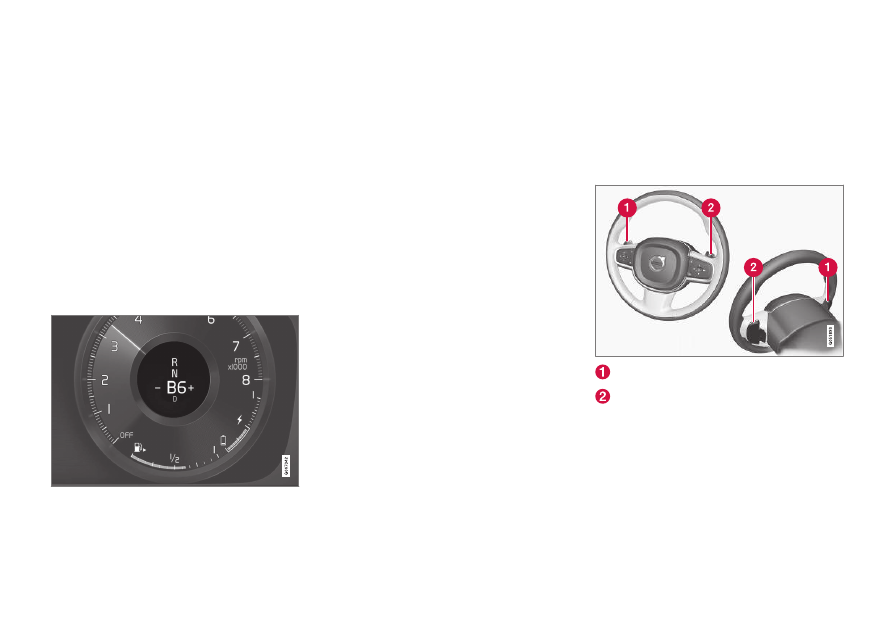
||
STARTING AND DRIVING
* Option/accessory.
462
Neutral – N
The car freewheels in position
N
. The car can
start in position
N
. Apply the parking brake if
the car is stationary with the gear selector in
the
N
position.
In order to change from
N
position to another
gear position, the brake pedal must be
depressed and the ignition position must be
II
.
Drive position - D
D
is the normal driving position. Shifting up
and down takes place automatically based on
the level of acceleration and speed.
The car must be stationary when changing
gear from
R
position to
D
position.
Brake – B
Overview of brake positions in the driver display.
In
B
position, it is possible to change gear
manually. The car brakes using its electric
motor when the accelerator pedal is released,
while also charging the hybrid battery.
Position
B
is selected by moving the gear
selector backwards from the
D
position.
•
Press the gear selector to the right to "
+
"
(plus) to change up one step and release
it.
•
Press the gear selector to the left to "
–
"
(minus) to change down one step and
release it.
•
Press the gear selector backwards to
return to the
D
position.
The gearbox automatically shifts down if the
speed decreases to a level lower than appro-
priate for the selected gear, in order to avoid
jerking and stalling.
Related information
•
•
Gear selector inhibitor (p. 464)
•
Changing gear with steering wheel pad-
dles
•
Changing gear with steering wheel
paddles
*
The steering wheel paddles are a comple-
ment to the gear selector and make it possi-
ble to change gear manually without releas-
ing hands from the steering wheel.
The function is available in position
D
or
B
.
"
-
": Selects the next lower gear.
"
+
": Selects the next higher gear.
Switch
To change gear:
–
Pull one of the paddles backwards -
towards the steering wheel - and release.
A gear change occurs at each pull of the pad-
dle, provided that the engine speed does not
leave the permitted range. The driver display
shows the current gear.
-------------------------------------------------------------------------------------------------------------------------------------------------------------
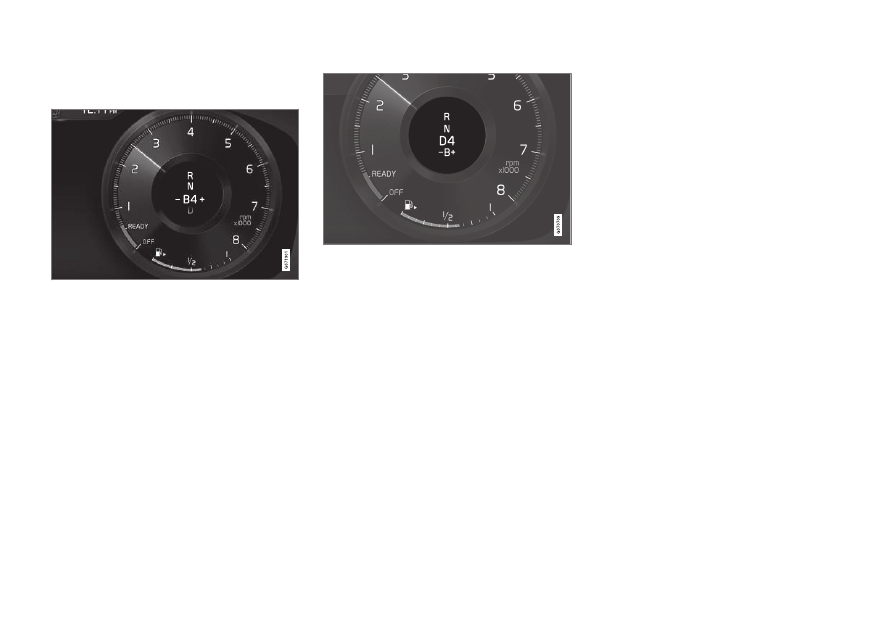
STARTING AND DRIVING
463
In
B
position the steering wheel paddles are
automatically activated.
Driver display when changing gear with steering
wheel paddles in manual gearshift mode.
Activating the steering wheel paddles
in position D
To be able to change gear with the steering
wheel paddles, they must be activated:
–
Pull one of the paddles toward the steer-
ing wheel.
> A figure in the driver display indicates
current gear.
Driver display when changing gear with steering
wheel paddles.
Deactivating the steering wheel
paddles in position D
Manual deactivation
–
Pull the right-hand paddle (
+
) toward the
steering wheel and hold in place until the
number in the driver display extinguishes.
> The gearbox returns to position
D
.
Automatic deactivation
The steering wheel paddles are deactivated
after a short time if they are not used. This is
indicated by means of the figure for the cur-
rent gear extinguishing. The exception is dur-
ing engine braking - then the paddles are acti-
vated for as long as engine braking is in pro-
gress.
Related information
•
•
Changing gear with automatic gearbox
(p. 461)
•
-------------------------------------------------------------------------------------------------------------------------------------------------------------

STARTING AND DRIVING
* Option/accessory.
464
Gear selector inhibitor
The gear selector inhibitor prevents acciden-
tal changing between different gear positions
in an automatic gearbox.
Automatic gear selector inhibitor
The automatic gear selector inhibitor has spe-
cial safety systems.
From park position – P or neutral position –
N
In order to move the gear selector from
P
or
N
position to another gear position, the brake
pedal must be depressed and the ignition
position must be
II
. For some gearbox vari-
ants, the engine must be running.
If the gear selector is in the
N
position and the
car has been stationary for at least 3 seconds
(irrespective of whether the engine is running)
then the gear selector is locked.
Message in the driver display
If the gear selector is inhibited a message is
shown in the driver display e.g.
Gear lever
Press brake pedal to activate gear lever
.
The gear selector is not inhibited mechanically.
Related information
•
•
Changing gear with automatic gearbox
(p. 461)
Kick-down function
Kick-down can be used when maximum
acceleration is needed such as for overtaking.
When the accelerator pedal is pressed all the
way to the floor (beyond the position normally
regarded as full acceleration) a lower gear is
immediately engaged. This is known as kick-
down.
If the accelerator is released from the kick-
down position, the gearbox automatically
changes up.
Safety function
To prevent over-revving of the engine, the
gearbox control program has a protective
downshift inhibitor.
The gearbox does not permit downshifting/
kick-down which would result in an engine
speed high enough to damage the engine.
Nothing happens if the driver still tries to shift
down in this way at high engine speed – the
original gear remains engaged.
On kick-down the car can shift down one or
more steps at a time, depending in engine
speed. The car shifts up when the engine has
reached is maximum engine speed in order to
prevent engine damage.
Related information
•
Launch function
*
Launch can be used when maximum acceler-
ation is required from stationary. The function
is available in the following drive modes:
Hybrid
,
Constant AWD
,
Power
and
Individual
.
Activate Launch
Make sure the car is stationary and the wheels
are pointing straight forward.
1. Move to gear position
D
.
2. Depress the brake pedal fully.
3. Then fully depress the accelerator pedal.
4. Release the brake pedal within 2 seconds.
If the Launch function does not work, wait
a few minutes and let the drivetrain cool
down to working temperature before retry-
ing.
The drivetrain is subject to wear and tear
when using Launch and therefore the func-
tion is only available a limited number of
times.
Related information
•
-------------------------------------------------------------------------------------------------------------------------------------------------------------
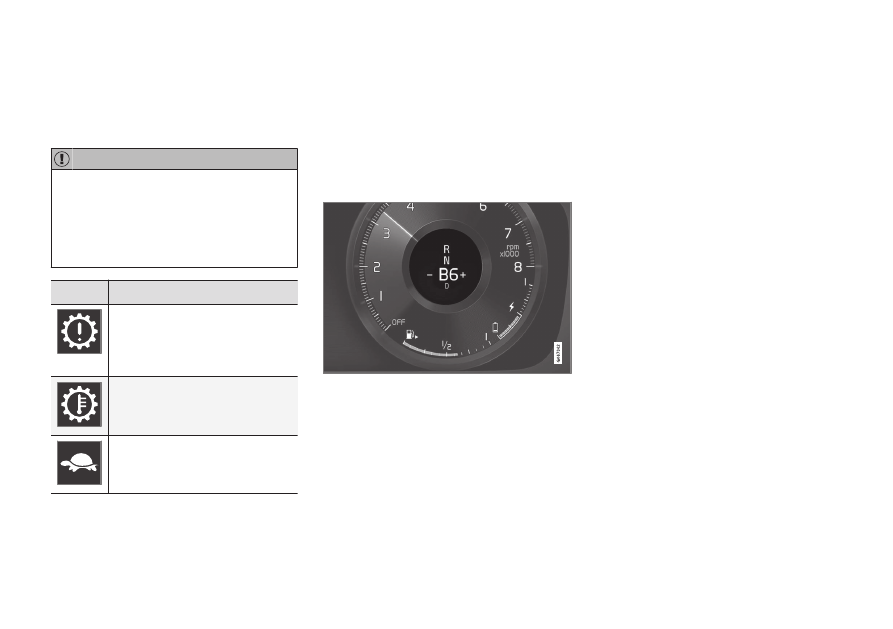
STARTING AND DRIVING
465
Symbols and messages for
automatic gearbox
If a fault should occur in the gearbox, a sym-
bol and a message are shown in the driver
display.
To prevent damage to any drive system
components, the working temperature of
the gearbox is checked. If there is a risk of
overheating, a warning symbol illuminates
in the driver display and a text message is
shown - follow the recommendation given.
Symbol Specification
An error has occurred in the
transmission.
Read the message in the driver
display.
Hot or overheated gearbox.
Read the message in the driver
display.
Temporary fault on drivetrain.
Read the message in the driver
display.
Related information
•
Gear shift indicator
The gear shift indicator in the driver display
shows the current gear during manual gear-
shifting and when it is appropriate to engage
the next gear for optimum fuel economy.
For eco-driving during manual gear changing,
it is important to drive in the right gear and to
change gear in good time.
Gear shift indicator in the driver display
5
.
The gear shift indicator is shown in gear posi-
tion
B
. The gear shift indicator shows the cur-
rent gear in the driver display and indicates
recommended shifting to a higher gear by a
flashing plus sign.
Related information
•
All-wheel drive
All-wheel drive (AWD
6
) means that the car is
driving all four wheels at the same time,
which improves traction.
The electric motor that drives the rear wheels
enables electric all-wheel drive functionality.
All-wheel drive characteristics vary depending
on the selected drive mode.
Related information
•
•
-------------------------------------------------------------------------------------------------------------------------------------------------------------
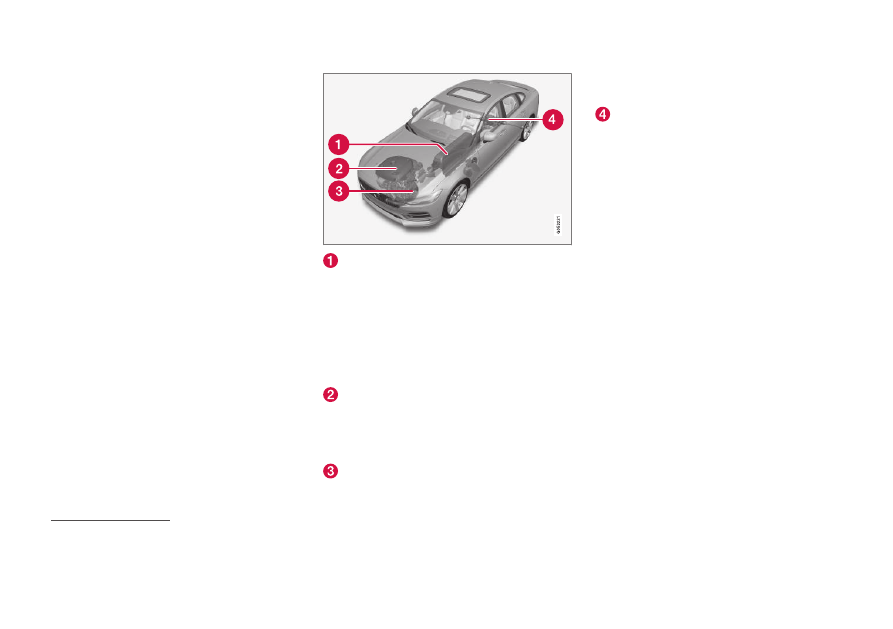
STARTING AND DRIVING
466
Drive systems
The car combines an internal combustion
engine that drives the front wheels with an
electric motor that drives the rear wheels.
Two drive systems
Depending on the driver-selected drive mode
and available electric energy, the two drive
systems can be used either individually or in
parallel.
The electric motor is supplied its energy from
a hybrid battery fitted in the tunnel console.
The hybrid battery can be charged in a wall
socket, or in a special charging station. The
internal combustion engine can also charge
the hybrid battery with a special high-voltage
generator.
Both the internal combustion engine and elec-
tric motor can generate motive force directly
to the wheels. An advanced control system
combines the properties of both drive systems
in order to provide optimum driving economy.
Hybrid battery - The function of the hybrid
battery is to store energy. It receives
energy when charging from the mains
power circuit, during regenerative braking
or from the high-voltage generator. It pro-
vides energy for electric operation as well
as for temporarily operating the electric air
conditioning during the preconditioning of
the passenger compartment.
Internal combustion engine - The internal
combustion engine starts when the
energy level in the hybrid battery is insuffi-
cient for the engine power that the driver
requests.
High voltage generator
7
- Charges the
hybrid battery. Starter motor for the inter-
nal combustion engine. Can support the
internal combustion engine with extra
electrical energy.
Electric motor - Powers the car in electric
operation. If necessary, provides extra tor-
que and power during acceleration. Pro-
vides electrical all-wheel drive functional-
ity. Recycles brake energy to electrical
energy.
Related information
•
General information on electric drive
(p. 424)
•
Starting and stopping the combustion
engine (p. 467)
•
•
5
The figure is schematic – parts may vary depending on car model.
6
All Wheel Drive
7
CISG (Crank Integrated Starter Generator) - Combined high-voltage generator and starter motor.
-------------------------------------------------------------------------------------------------------------------------------------------------------------

STARTING AND DRIVING
}}
467
Starting and stopping the
combustion engine
An advanced control system determines the
extent to which the car is driven on internal
combustion engine, electric motor or both in
parallel. During electric operation, the car
may sometimes need to start the internal
combustion engine automatically due to
external circumstances, e.g. in low outside
temperatures, which is completely normal. In
addition, the internal combustion engine
always starts when the hybrid battery rea-
ches its lowest state of charge.
Climate settings at low temperatures
In low outside temperatures, the internal com-
bustion engine sometimes starts automatically
in order to achieve the desired passenger
compartment temperature and air quality. The
amount of time that the internal combustion
engine runs can be affected by
•
lowering the temperature
•
reducing the fan strength
•
activating drive mode
Pure
.
Electric operation in low or high
temperatures
In low or high outside temperatures, the car's
range and output for electric operation may be
reduced and affect how often the internal
combustion engine is started automatically.
Emission control
To ensure that emission control operates as
energy-efficiently as possible, the internal
combustion engine must be run for several
minutes once it has been started. The duration
of the internal combustion engine's running
time varies depending on the temperature of
the catalytic converter.
Related information
•
•
•
•
Drive modes
Selection of drive mode affects the car's driv-
ing characteristics in order to enhance the
driving experience and facilitate driving in
special situations.
Using the drive modes it is possible to quickly
have access to the car's numerous functions
and settings for different driving needs. Each
drive mode is adapted to provide optimum
driving characteristics:
•
Steering
•
Engine/gearbox/all-wheel drive
•
Brakes
•
Shock absorption
•
Driver display
•
Climate settings
Select the drive mode adapted for the current
driving conditions. Remember that not all
drive modes are available in all situations.
Selectable drive modes
WARNING
Remember that the car does not emit any
engine noise when it is only powered by
the electric motor and may therefore be
difficult to notice by children, pedestrians,
cyclists and animals. This applies in partic-
ular at low speeds such as in car parks.
-------------------------------------------------------------------------------------------------------------------------------------------------------------
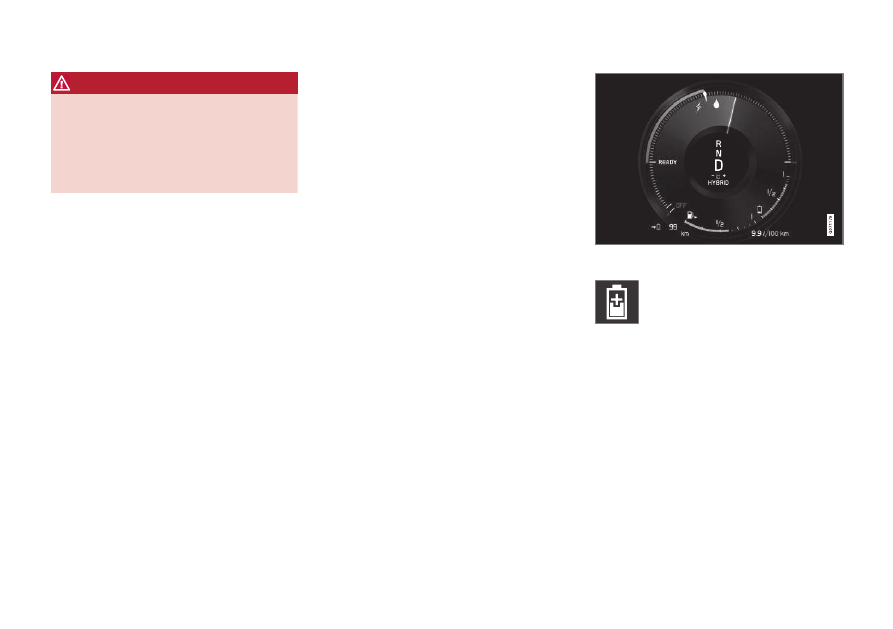
||
STARTING AND DRIVING
468
WARNING
Do not leave the car in an unventilated area
with activated drive mode and the fuel-
driven engine switched off - automatic
engine start occurs at low energy level in
the hybrid battery, and the exhaust gases
could then cause serious injury to people
and animals.
Hybrid
•
This is the car's normal mode where the
electric motor and internal combustion
engine work together.
When the car starts, it is in the
Hybrid
mode.
The control system uses both the electric
motor and internal combustion engine – indi-
vidually or in parallel – and adapts use with
regard to performance, fuel consumption and
comfort. The capacity to run solely with the
electric motor depends on the hybrid battery's
energy level and, for example, the need for
heating or cooling in the passenger compart-
ment.
If high power output is available, it is possible
to drive with electrical power alone. When the
accelerator pedal is depressed, only the elec-
tric motor is activated until a certain position is
reached. The internal combustion engine
starts when this position is exceeded and the
energy level in the battery is insufficient for the
engine power that the driver requests with the
accelerator pedal.
At low energy level (hybrid battery almost
empty) the battery's energy level must be
maintained, leading to the internal combustion
engine starting more often. Charge the hybrid
battery from a 230 VAC socket with the
charging cable, or activate
Charge
in the func-
tion view in order to restore the capacity to
run on electricity alone.
The drive mode is designed for low energy
consumption with a mix of the electric motor
and the internal combustion engine, without
compromising the climate comfort and driving
experience. When higher acceleration is
required, maximum additional power from the
electric drive line is used.
The car also senses if the driving conditions
require all-wheel drive and automatically
engages it if necessary. All-wheel drive and
electric additional power are always available
regardless of the battery's state of charge.
Information in the driver display
When driving in hybrid mode the driver display
shows a hybrid gauge. The pointer in the
hybrid gauge indicates how much energy the
driver requests with the accelerator pedal. The
marking between the lightning bolt and the
drop shows how much energy is available.
The driver display for propulsion with both the elec-
tric motor and internal combustion engine.
The driver display also shows when
energy is returned to the battery
(regenerated) during light braking.
-------------------------------------------------------------------------------------------------------------------------------------------------------------

STARTING AND DRIVING
}}
469
Pure
•
Drive the car with electric motor, with
energy consumption as low as possible
and with lowest possible carbon dioxide
emissions.
The drive mode prioritises driving on the
hybrid battery. This means, for example, that
the output of certain climate settings is
reduced to provide the longest possible mile-
age on electric power alone.
The
Pure
mode is available when the hybrid
battery has a sufficiently high energy level. The
internal combustion engine also starts in the
Pure
mode if the energy level in the battery
falls too low. The internal combustion engine
also starts
•
if the speed exceeds 125 km/h (78 mph)
•
if the driver requests more motive force
than electric drive can provide
•
in the event of system/component limita-
tions e.g. low outside temperature.
The internal combustion engine may start
temporarily in certain driving situations
when the
Pure
drive mode is in use. This is
in order to provide the wheels with the
desired torque in driving situations that
require higher load, e.g. when driving with
a trailer or on an uphill gradient.
The drive mode is adapted for maximum range
with electric propulsion and especially devel-
oped for urban traffic.
Pure
means lowest
combustion even when the hybrid battery is
empty. The climate in the passenger compart-
ment is regulated to Eco climate, and in slip-
pery driving conditions, more wheel spin can
be permitted before all-wheel drive is acti-
vated automatically.
ECO climate control
In the
Pure
drive mode, eco climate control is
activated automatically in the passenger com-
partment in order to reduce energy consump-
tion.
When the
Pure
drive mode is activated,
several parameters in the climate control
system's settings are changed, and several
electricity consumer functions are reduced.
Certain settings can be reset manually, but
full functionality is only regained by leaving
Pure
drive mode or adapting
Individual
drive mode with full climate functionality.
In the event of difficulties due to misting,
press the button for max. defroster which has
normal functionality.
Constant AWD
•
Improve the car's roadholding and traction
with enhanced all-wheel drive.
The drive mode locks the car in all-wheel drive.
An adapted distribution between the front and
rear axle torque provides good traction, stabil-
ity and roadholding, for example on slippery
roads, when driving with a heavy trailer, or
when towing.
Constant AWD
drive mode is
always available regardless of the battery's
state of charge.
Both the internal combustion engine and elec-
tric motor are engaged in order to drive all four
wheels, which results in increased fuel con-
sumption.
In the car's other drive modes, the car auto-
matically adapts the need for all-wheel drive to
the road surface, and can engage the electric
motor or start the internal combustion engine
when necessary.
-------------------------------------------------------------------------------------------------------------------------------------------------------------
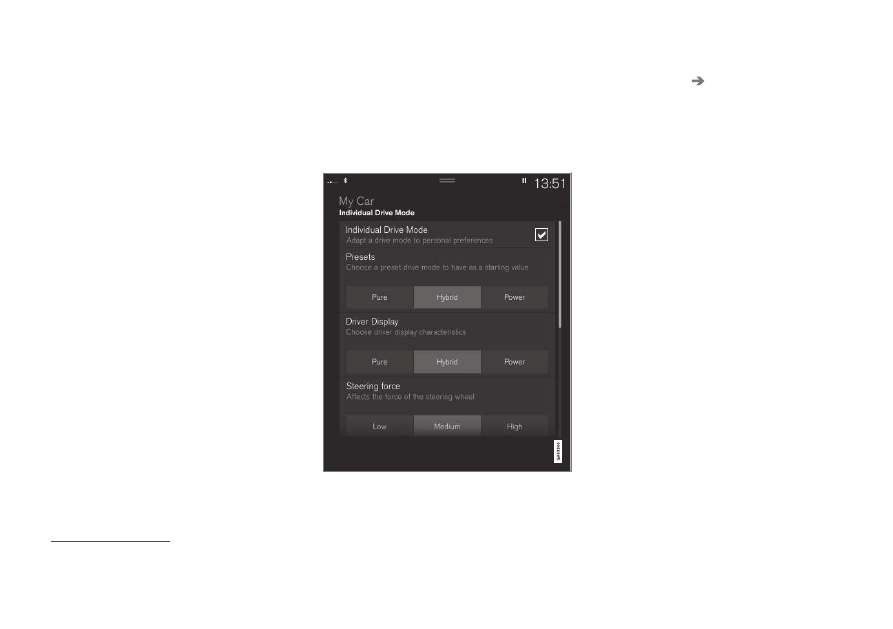
||
STARTING AND DRIVING
* Option/accessory.
470
Power
•
The car has sportier characteristics and
faster response to accelerating.
The drive mode adapts the combined power
from the internal combustion engine and elec-
tric motor by means of the car being driven by
both front and rear wheels. The gear changes
become faster and more distinct, and the
gearbox prioritises a gear with greater trac-
tion. Steering response is faster and shock
absorption is harder.
Both the internal combustion engine and elec-
tric motor are engaged in order to drive all four
wheels, which results in increased fuel con-
sumption.
The drive mode is adapted for maximum per-
formance and response on acceleration. It
changes the internal combustion engine's
accelerator pedal response, gear shift pattern
and boost pressure system. Chassis settings,
steering and brake response are also as good
as possible.
Power
drive mode is always avail-
able regardless of the battery's state of
charge.
The
Power
mode is also available in the
Polestar Engineered
version
*
.
Individual
•
Adapting a drive mode according to indi-
vidual preferences.
Select a drive mode to start from, and then
adjust the settings according to the desired
driving characteristics. These settings are
saved in an individual driver profile.
An individual drive mode is only available if it is
first activated in the centre display.
Settings view
8
for individual drive mode.
1. Press
Settings
in the top view.
2. Press
My Car
Individual Drive Mode
and select
Individual Drive Mode
.
3. In
Presets
, select a drive mode to start
from:
Pure
,
Hybrid
,
Power
or
Polestar
Engineered
*
.
Possible adjustments apply to settings for:
•
Driver Display
•
Steering Force
•
Powertrain Characteristics
•
Brake Characteristics
•
Suspension Control
•
ECO Climate
Using the electric motor or internal
combustion engine
An advanced control system determines the
extent to which the car is driven on internal
combustion engine, electric motor or both in
parallel.
The primary function is to use the engine or
motor and the available energy in the hybrid
battery as efficiently as possible, with regard
to the characteristics of the different drive
modes as well as the driver's request for
power via the accelerator pedal.
There are also cases where temporary limita-
tions in the system, or functions governed by
8
The figure is schematic - parts may vary depending on car model.
-------------------------------------------------------------------------------------------------------------------------------------------------------------

STARTING AND DRIVING
* Option/accessory.
471
legal requirements aimed at maintaining a low
level of total emissions for the car, may use
the internal combustion engine to a greater
extent.
Related information
•
•
•
Energy distribution using map data
•
•
General information on electric drive
(p. 424)
•
Changing drive mode
Select the drive mode adapted for the current
driving conditions.
Change the drive mode using the control in
the centre console.
Remember that not all drive modes are availa-
ble in all situations.
To change drive mode:
1. Press the drive mode control
DRIVE
MODE
.
> A pop-up menu is opened in the centre
display.
2. Roll the wheel upward or downward until
the desired drive mode is highlighted.
3. Press the drive mode control or tap
directly on the touch screen to confirm the
selection.
> The selected drive mode is indicated in
the driver display.
Related information
•
-------------------------------------------------------------------------------------------------------------------------------------------------------------

STARTING AND DRIVING
* Option/accessory.
472
Energy distribution using map
data
*
In the driving position
Hybrid
the car is pow-
ered by both the electric motor and the inter-
nal combustion engine. If a destination has
been selected in the navigation system
*
, the
Predictive Efficiency
9
function distributes the
electric energy consumption along the whole
driving distance using the map data.
In addition to the map data, the function also
takes into account speed limits, traffic and ele-
vation differences.
The electric motor is used primarily when driv-
ing at low speeds e.g. during city driving with
more stops and starts. The combustion engine
is used primarily when driving at high speeds
and can, in good conditions, generate power
for the electric motor.
Conditions for the function
For the function to work requires that a num-
ber of conditions are met:
•
A destination is set in the navigation sys-
tem and the driving distance to the desti-
nation is longer than the range possible
only on electric drive.
•
Hybrid
drive mode is selected.
•
The
Hold
and
Charge
functions are deac-
tivated.
Tips for use
If the car is used for commuting to work and it
is not possible to charge the car at the place of
work, specify the place of work as an inter-
mediate destination and your home as the
final destination. The discharging of the hybrid
battery will then take place over your runs
both to and from work.
Add similar commuting routes, i.e. the route
between two charging points, as
Favourites
in the navigation system to facilitate arrival.
Related information
•
•
•
9
Certain markets only.
-------------------------------------------------------------------------------------------------------------------------------------------------------------
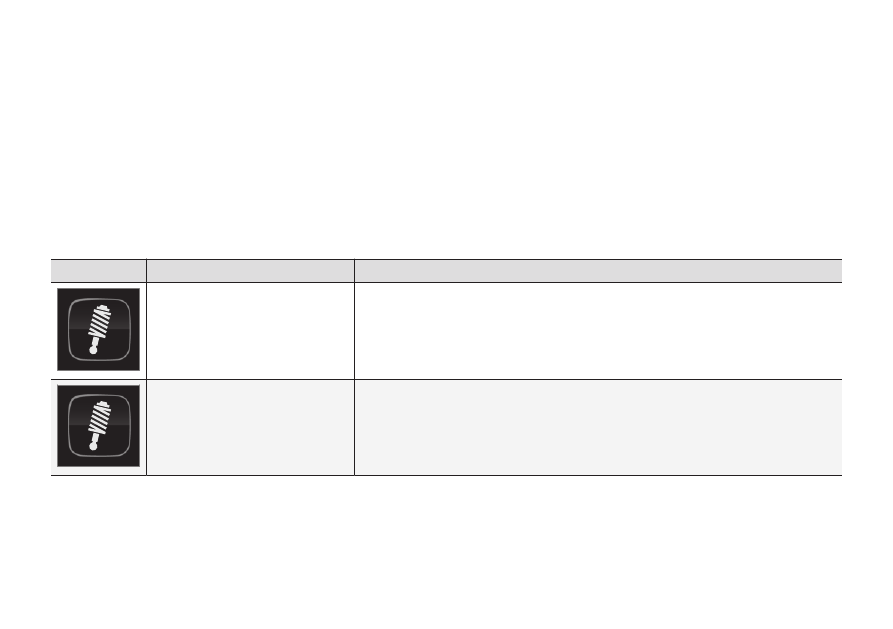
STARTING AND DRIVING
}}
* Option/accessory.
473
Level control
*
and shock
absorption
Level control and shock absorption are regu-
lated automatically in the car.
With rear level control, the car maintains the
same height at the rear regardless of load.
Level control can also occur even after the car
has been parked.
Shock absorption (Four-C)
On a car equipped with Four-C the shock
absorption is adapted according to the drive
mode selected and the speed of the car.
Shock absorption is normally set for optimum
comfort and is regulated continuously depend-
ing on the road surface, the car's acceleration,
braking and cornering.
During transport
During transport of the car on a ferry, train or
truck, the car must be lashed around the tyres
and not around other parts of the chassis.
Changes in the air suspension may occur dur-
ing transport, which could affect the lashing
negatively.
Symbols and messages
If a fault arises with the level control, a mes-
sage is shown in the driver display.
Symbol
Message
Specification
Suspension
Deactivated by user
The active suspension has been switched off manually by the user.
Suspension
Temporarily reduced performance
The active suspension's performance has been temporarily reduced due to extensive sys-
tem use.
-------------------------------------------------------------------------------------------------------------------------------------------------------------

||
STARTING AND DRIVING
474
Symbol
Message
Specification
Suspension
Service required
A fault has occurred. Visit a workshop
A
as soon as possible.
Suspension failure
Stop safely
A critical fault has occurred. Stop safely, have the car transported (raised with all wheels
on the flat-bed) to a workshop
A
.
Suspension
Slow down Car too high
A fault has occurred. If the message appears whilst driving, contact a workshop
A
.
Suspension
Auto adjusting car level
Level control of the car's rear axle to target height in progress.
A
An authorised Volvo workshop is recommended.
-------------------------------------------------------------------------------------------------------------------------------------------------------------

STARTING AND DRIVING
* Option/accessory.
475
Related information
•
•
-------------------------------------------------------------------------------------------------------------------------------------------------------------

STARTING AND DRIVING
* Option/accessory.
476
Settings for level control
*
Switch off the level control when the car is to
be jacked up in order to prevent problems
with automatic regulation.
Settings in the centre display
Disable Leveling Control
In certain cases the function must be deacti-
vated e.g. before the car is raised with a jack
*
.
The difference in level created when lifting
with a jack would otherwise mean the auto-
matic control starting to adjust the height, cre-
ating an undesired effect.
Deactivating the function via the centre dis-
play:
1. Press
Settings
in the top view.
2. Press
My Car
Parking Brake and
Suspension
.
3. Select
Disable Leveling Control
.
Related information
•
•
Recommendations for loading (p. 595)
Economical driving
To achieve the longest possible range, the
driver should plan driving and adapt driving
style and speed to the prevailing situation.
Before driving
•
Precondition the car before driving if pos-
sible using the charging cable connected
to the mains power circuit.
•
If preconditioning is not possible when it
is cold outside, use seat heating and steer-
ing wheel heating first of all. Avoid warm-
ing up the whole of the interior which
takes energy from the hybrid battery.
•
Choice of tyres and tyre pressure can
affect energy consumption - seek advice
on suitable tyres from an authorised Volvo
dealer.
•
Remove unnecessary items from the car -
the greater the load the higher the con-
sumption.
While driving
•
Activate drive mode
Pure
.
•
Activate the
Hold
function at higher
speeds during journeys that are longer
than the range of the electricity.
•
If possible, avoid using the
Charge
func-
tion to charge the hybrid battery.
•
Drive at a steady speed and keep a good
distance to other vehicles and objects in
order to avoid braking.
•
The hybrid battery is recharged during
braking by braking gently with the brake
pedal.
•
High speed results in increased energy
consumption since the wind resistance
increases with speed.
•
In a cold climate, reduce electrical heating
of windows, mirrors, seats and steering
wheel, if possible.
•
Avoid driving with open windows.
•
Do not hold the car stationary on a hill
with the accelerator pedal. Instead, acti-
vate the function for braking when station-
ary.
•
If possible, deactivate the climate control
while driving a short distance after pre-
conditioning.
After driving
•
If possible, park in an acclimated garage
with charging facilities.
Related information
•
•
•
Checking tyre pressure (p. 568)
•
-------------------------------------------------------------------------------------------------------------------------------------------------------------
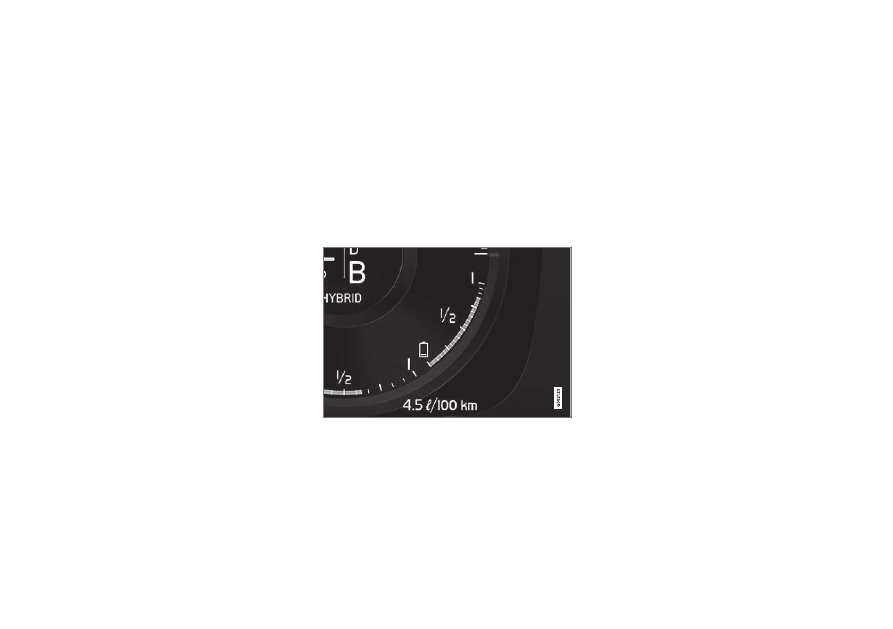
STARTING AND DRIVING
}}
477
•
Automatic braking when stationary
(p. 457)
•
Range
The car's range depends on several factors.
The ability to achieve a long range varies
according to the circumstances and condi-
tions under which the car is being driven.
The certified value for the car's mileage should
not be interpreted as an expected range. The
certified value should primarily be used to
compare different cars and is obtained during
special test cycles.
Range in the driver display
When the car is delivered from the factory, or
after a factory reset, the range is based on the
certified value
When the car has been driven for a while, the
range is based on historical driving patterns.
The amount of history used depends on the
battery's state of charge. Therefore, the less
charge there is in the hybrid battery, the faster
the range adapts to a changed driving pattern.
Factors that affect the range
In addition to historical trip data, there are sev-
eral different factors that affect the range. The
longest range is achieved under extremely
favourable conditions when all factors have a
positive impact.
Examples of factors that affect the range:
•
speed
•
climate settings
•
topography
•
preconditioning
•
tyres and tyre pressure
•
traffic situation
•
temperature and weather
•
road conditions.
-------------------------------------------------------------------------------------------------------------------------------------------------------------

Нет комментариевНе стесняйтесь поделиться с нами вашим ценным мнением.
Текст